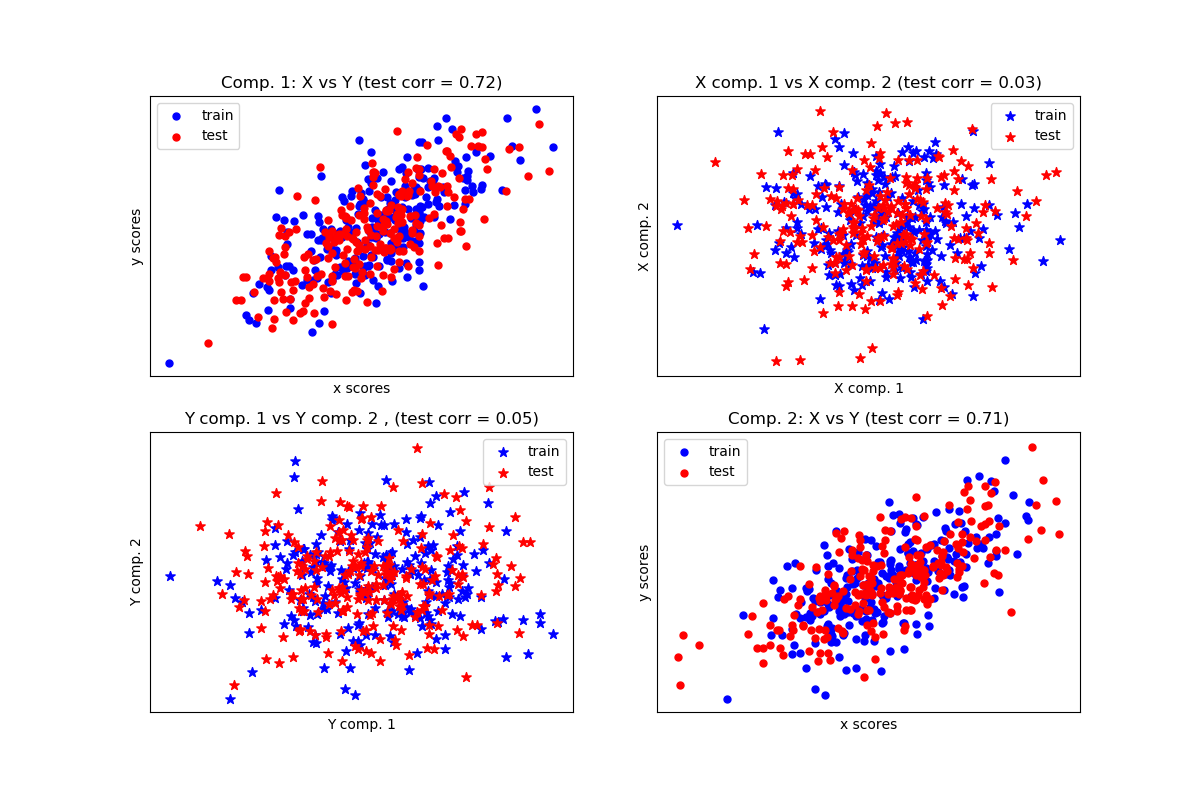sklearn.cross_decomposition.PLSCanonical¶
class sklearn.cross_decomposition.PLSCanonical(n_components=2, *, scale=True, algorithm='nipals', max_iter=500, tol=1e-06, copy=True)
[源码]
PLSCanonical实现了原始Wold算法的2块规范PLS [Tenenhaus 1998] p.204,在[Wegelin 2000]中称为PLS-C2A。
此类从PLS继承,mode=“A”且deflation_mode =“ canonical”,norm_y_weights = True,algorithm =“ nipals”,只是svd会提供类似的结果,直至出现数值错误。
在用户指南中阅读更多内容。
0.8版的新功能。
| 参数 | 说明 |
|---|---|
| n_components | int, (default 2) 要保留的组件数量 |
| scale | boolean, (default True) scale数据选项 |
| algorithm | string, “nipals” or “svd” 用于估计权重的算法。 称为n_components次,即外循环的每次迭代时执行一次。 |
| max_iter | an integer, (default 500) NIPALS内循环的最大迭代次数(仅当algorithm =“ nipals”时使用) |
| tol | non-negative real, default 1e-06 迭代算法中使用的容差 |
| copy | boolean, default True 是否应在副本上进行紧缩。 通常将默认值设为True,除非您不担心副作用 |
| 属性 | 说明 |
|---|---|
| x_weights_ | array, shape = [p, n_components] X权重向量。 |
| y_weights_ | array, shape = [q, n_components] Y权重向量。 |
| x_loadings_ | array, shape = [p, n_components] X加载向量。 |
| y_loadings_ | array, shape = [q, n_components] Y加载向量。 |
| x_scores_ | array, shape = [n_samples, n_components] X得分。 |
| y_scores_ | array, shape = [n_samples, n_components] Y得分。 |
| x_rotations_ | array, shape = [p, n_components] X潜在旋转。 |
| y_rotations_ | array, shape = [q, n_components] Y潜在旋转。 |
| coef_ | array of shape (p, q) 线性模型的系数:Y = X coef_ + Err |
| n_iter_ | array-like 每个组件的NIPALS内部循环的迭代次数。 如果提供的算法是“ svd”,则不起作用。 |
另见:
注
矩阵:
T: x_scores_
U: y_scores_
W: x_weights_
C: y_weights_
P: x_loadings_
Q: y_loadings__
计算如下:
X = T P.T + Err and Y = U Q.T + Err
T[:, k] = Xk W[:, k] for k in range(n_components)
U[:, k] = Yk C[:, k] for k in range(n_components)
x_rotations_ = W (P.T W)^(-1)
y_rotations_ = C (Q.T C)^(-1)
其中Xk和Yk是迭代k的残差矩阵。
对于每个分量k,找到优化的权重u,v:
max corr(Xk u, Yk v) * std(Xk u) std(Yk u), such that ``|u| = |v| = 1``
注意,它使得分和块内方差之间的相关性最大化。
X(Xk + 1)块的残差矩阵是通过对当前X分数x_score的收缩获得的。
Y(Yk + 1)块的残差矩阵是通过对当前Y分数进行收缩获得的。 这将执行PLS回归的规范对称版本。 但与CCA略有不同。 这主要用于建模。
此实现使用函数plsca(X,Y)提供与R语言(R-project)中提供的“plspm”包相同的结果。 结果与“mixOmics”包的函数pls(...,mode ="canonical")相等或共线。不同之处在于,由于mixOmics实现未将y_weights归一化,因此它并未完全实现Wold算法。
参考
Jacob A. Wegelin. A survey of Partial Least Squares (PLS) methods, with emphasis on the two-block case. Technical Report 371, Department of Statistics, University of Washington, Seattle, 2000.
Tenenhaus, M. (1998). La regression PLS: theorie et pratique. Paris: Editions Technic.
示例
>>> from sklearn.cross_decomposition import PLSCanonical
>>> X = [[0., 0., 1.], [1.,0.,0.], [2.,2.,2.], [2.,5.,4.]]
>>> Y = [[0.1, -0.2], [0.9, 1.1], [6.2, 5.9], [11.9, 12.3]]
>>> plsca = PLSCanonical(n_components=2)
>>> plsca.fit(X, Y)
PLSCanonical()
>>> X_c, Y_c = plsca.transform(X, Y)
| 方法 | 说明 |
|---|---|
fit(self, X, Y) |
用模型训练数据 |
fit_transform(self, X[, y]) |
在训练集上学习并应用降维 |
get_params(self[, deep]) |
获取评估器参数 |
inverse_transform(self, X) |
将数据转换回其原始空间。 |
predict(self, X[, copy]) |
(self, X[, copy]) |
score(self, X, y[, sample_weight]) |
返回预测的确定系数R^2。 |
transform(self, X[, Y, copy]) |
应用从训练集学习到的降维 |
set_params(self, **params) |
设置此估算器的参数。 |
__init__(self, n_components=2, *, scale=True, algorithm='nipals', max_iter=500, tol=1e-06, copy=True)
[源码]
初始化self。 有关准确的签名,请参见help(type(self))。
fit(self, X, Y)
[源码]
应用在训练集上学习的降维。
| 参数 | 说明 |
|---|---|
| X | array-like of shape (n_samples, n_features) 训练向量,其中n_samples是样本数,n_features是预测变量数。 |
| y | array-like of shape (n_samples, n_targets) 目标向量,其中n_samples是样本数,n_targets是响应变量数。 |
| 返回值 |
|---|
| 如果未指定Y,则为x_scores,否则为(x_scores,y_scores)。 |
get_params(self, deep=True)
[源码]
获取此估计量的参数。
| 参数 | 说明 |
|---|---|
| deep | bool, default=True 如果为True,则将返回此估算器和作为估算器的所包含子对象的参数。 |
| 返回值 | 说明 |
|---|---|
| params | mapping of string to any 参数名称映射到其值。 |
inverse_transform(self, X)
将数据转换回其原始空间。
| 参数 | 说明 |
|---|---|
| X | array-like of shape (n_samples, n_components) 新数据,其中n_samples是样本数,n_components是pls分量数。 |
| 返回值 | 说明 |
|---|---|
| x_reconstructed | array-like of shape (n_samples, n_features) |
注
仅当n_components = n_features时,此转换才是精确的
predict(self, X, copy=True)
应用在训练集上学习到的降维
| 参数 | 说明 |
|---|---|
| X | array-like of shape (n_samples, n_features) 训练向量,其中n_samples是样本数,n_features是预测变量数。 |
| copy | boolean, default True 是复制X和Y,还是执行就地归一化。 |
注
该调用需要估计p x q矩阵,这在高维空间中可能是个问题。
score(self, X, y, sample_weight=None)
返回预测的确定系数R^2。
系数R^2定义为(1-u/v),其中u是平方的残差和((y_true-y_pred)** 2).sum(),而v是平方的总和((y_true- y_true.mean())** 2).sum()。 可能的最高得分为1.0,并且可能为负(因为该模型可能会更差)。 不管输入特征如何,始终预测y的期望值的常数模型将获得0.0的R^2分数。
| 参数 | 说明 |
|---|---|
| X | array-like of shape (n_samples, n_features) 测试样本。对于某些估计量,可以是预先计算的内核矩阵或通用对象列表,shape =(n_samples,n_samples_fitted),其中n_samples_fitted是用于估计量拟合的样本数。 |
| y | array-like of shape (n_samples,) or (n_samples, n_outputs) X的真实值。 |
| sample_weight | array-like of shape (n_samples,), default=None 样本权重 |
| 返回值 | 说明 |
|---|---|
| score | float 关于y的self.predict(X)的R^2。 |
注
用0.23版本multioutput ='uniform_average'在回归器上调用score时,使用的R2得分,使之与r2_score的默认值保存一致。 这会影响所有多输出回归器的score方法(MultiOutputRegressor除外)。
set_params(self, **params)
设置此估算器的参数。
该方法适用于简单的估计器以及嵌套对象(例如管道)。 后者的参数格式为<component> __ <parameter>,以便可以更新嵌套对象的每个组件。
| 参数 | 说明 |
|---|---|
| **params | dict 估算器参数。 |
| 返回值 | 说明 |
|---|---|
| self | object 估算器实例。 |
transform(self, X, Y=None, copy=True)
应用在训练集上学习到的降维。
| 参数 | 说明 |
|---|---|
| X | array-like of shape (n_samples, n_features) 训练向量,其中n_samples是样本数,n_features是预测变量数。 |
| Y | array-like of shape (n_samples, n_targets) 目标向量,其中n_samples是样本数,n_targets是响应变量数。 |
| copy | boolean, default True 是复制X和Y,还是执行就地归一化。 |
| 返回值说明 |
|---|
| 如果未指定Y,则为x_scores,否则为(x_scores,y_scores)。 |





